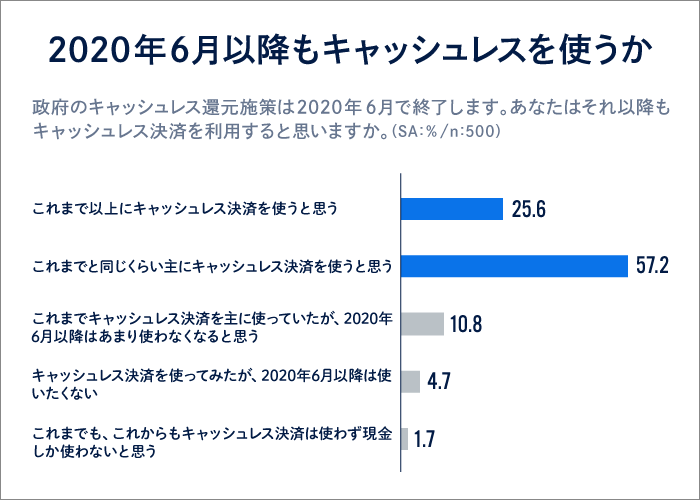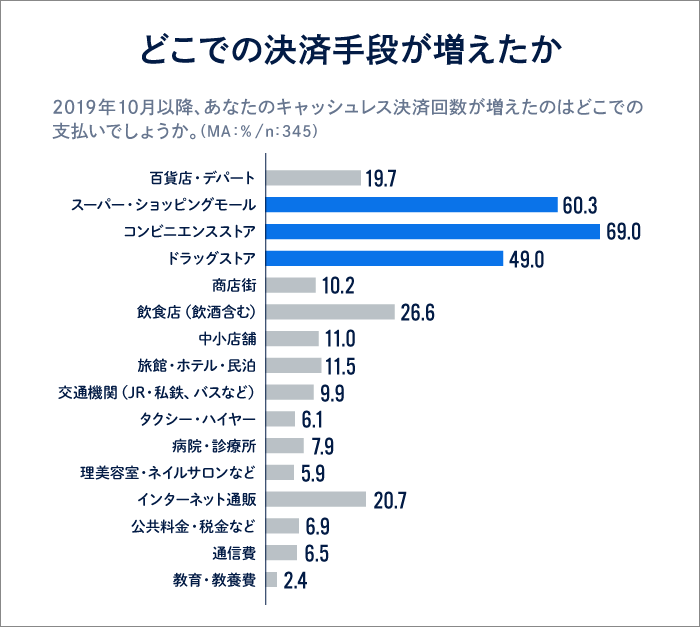October 1, 2019.
With the start of the consumption tax hike, the government introduced cashless rebate measures.
Japan, often called a "cashless laggard" globally.
With the government's cashless promotion efforts now in full swing, it's fair to say the curtain has finally risen on "Cashless Japan."
Amid the rapid expansion of mobile payments, implementation and monetization are progressing not only among existing industries like card companies and banks, but also among major players across various sectors. In particular, the platform operators in the "three major industries" – telecommunications, distribution, and transportation – are aggressively leveraging cashless payments to advance their economic sphere businesses.
Positioning this very moment as the start of "Cashless Japan," Dentsu Inc. Business Co-creation Unit's Cashless Project conducted its own "Cashless Awareness Survey." Based on these findings, we examine how consumers' cashless habits are changing and the current state of "Cashless Japan."
Approximately 70% of consumers report "increased frequency of cashless payments"
Since the government launched cashless rebate measures as a countermeasure to the consumption tax hike, 71.0% of consumers report that their "frequency of using cashless payments has increased," indicating steady growth. Particularly noteworthy is the trend among "cash users." Japanese people are often said to prefer cash. How have these individuals shifted their behavior?
Among the survey results,
"I only used cash before, but now I use cashless payments" (5.6%)
"I used cash more than cashless payments before, but now cashless payments have increased" (18.1%)
These responses accounted for 23.7% of the total, clearly indicating a steady shift toward cashless payments among cash users. As the title suggests, "A Crack in the Wall of Cash," doesn't this cashless shift also appear to show that "even Japan's cash-loving population is showing cracks"?
So, what are the reasons behind the steady growth of cashless payments among consumers?
When asked why they use cashless payments more frequently, the top reasons were: "To take advantage of the government's cashless rebate program" (49.3%), "Payment company campaigns and benefits were attractive" (40.0%), and "Payment speed at the register is faster" (36.4%).
These results clearly show that incentives from the government and cashless providers, along with the inherent value of speed offered by cashless payments, are driving consumers toward cashless adoption.
The growth in cashless payments occurred at familiar touchpoints
Where exactly did consumers' cashless payments increase?
The places where cashless payment frequency increased most were: "Convenience stores" (69%), "Supermarkets/Shopping malls" (60.3%), and "Drugstores" (49.0%).
This indicates that cashless payments are increasing at contact points consumers frequently use in their daily lives, suggesting that cashless is becoming a familiar presence for consumers and permeating everyday life.
Smartphone payments saw the biggest increase
So, which payment methods saw the most growth?
The most frequently cited method was "mobile QR payments" (58.1%), followed by "credit cards" (55.7%).
This means mobile QR payments have overtaken credit cards, a long-established cashless payment method, as the fastest-growing option.
Looking back over the past decade, globally, the trend began with Google Wallet in 2010 and accelerated with Apple Pay in 2014. In Japan too, with Rakuten Pay in 2016 and PayPay in 2018, it's clear that smartphones fundamentally transformed cashless payments in the 2010s. Considering this context, it's fair to say that "smartphone payments" are the driving force behind Cashless Japan.
Small-amount payments growing with smartphone payments
What is the typical transaction amount for the increasing number of smartphone payments?
Looking at the average transaction amount, credit cards average ¥6,747, while mobile QR payments, for example, average ¥1,957 – clearly smaller transactions. Historically, cashless methods like credit cards were more common for high-value purchases than cash, while cash was more prevalent for smaller transactions. The fact that this shift is now occurring in the lower-value segment might symbolize a "breach in the wall of cash" for small payments.
Approximately 80% of consumers intend to "continue using cashless payments."
As seen previously, cashless payments are currently performing well. But what will happen to consumers' cashless trends going forward?
According to this survey, 82.8% of consumers stated they would continue using cashless payments even after the government's cashback incentive program ends in June 2020. This indicates a strong intention to maintain cashless usage going forward. These findings suggest the current growth in cashless payments is not temporary and is likely to continue steadily.
2020 will see the Tokyo Olympic and Paralympic Games. Furthermore, the Ministry of Health, Labour and Welfare is advancing discussions on initiatives such as electronic currency payroll payments, driven by its policy to revise ministerial ordinances. Against this backdrop, Dentsu Inc.'s Cashless Project anticipates that "Cashless Japan" will continue to gain momentum, with "smartphone payments" playing a leading role.

<DENTSU Inc. Cashless Project>
For details on the Cashless Project, please contact Yoshitomi at Dentsu Inc. BD&A Division, Business Infrastructure Development Department ( cashless@dentsu.co.jp ).
【Survey Overview】
◇Survey Method: Internet survey
◇Survey Period: November 16-17, 2019
◇Survey Area: Nationwide
◇Survey Subjects: ① General consumers, ② Small and medium-sized enterprise (SME) owners*
① 500 men and women aged 20–69 (weighted based on population composition)
② 335 men and women aged 20–69 (weighted based on occurrence rate)
※ SMEs in the food service or retail industry with 100 or fewer employees and capital of 50 million yen or less








